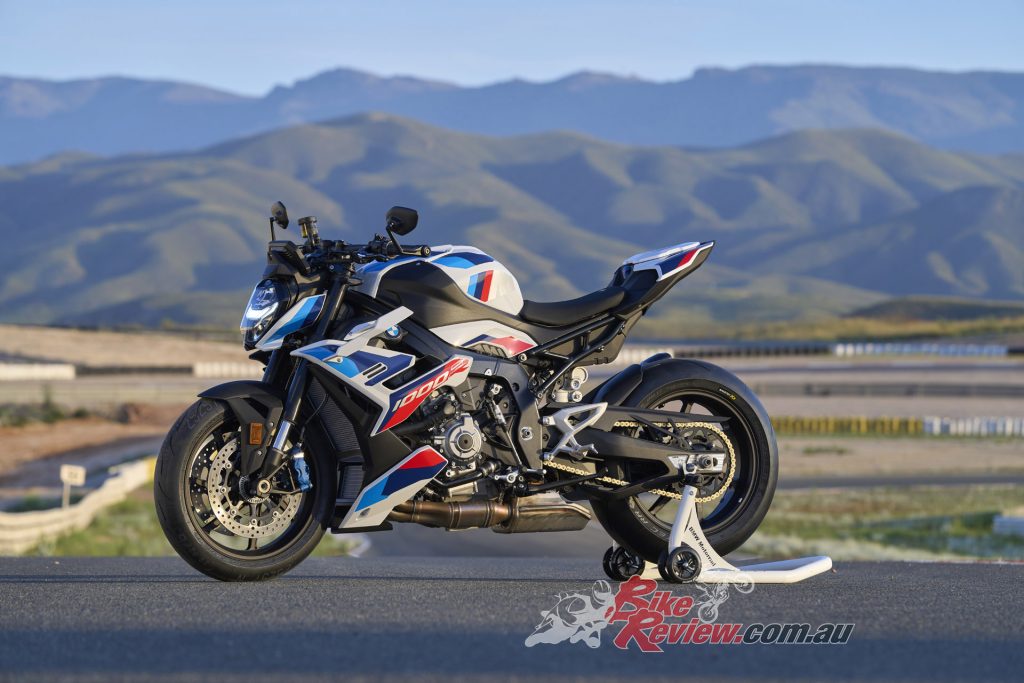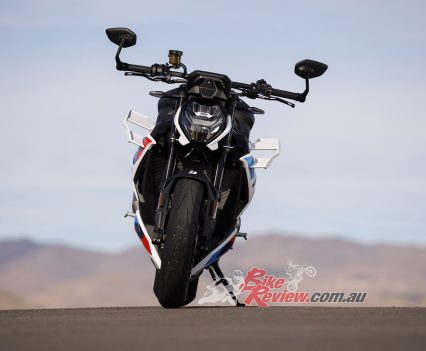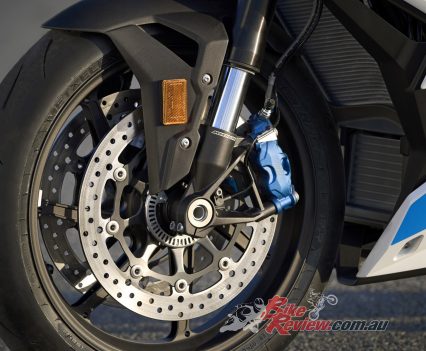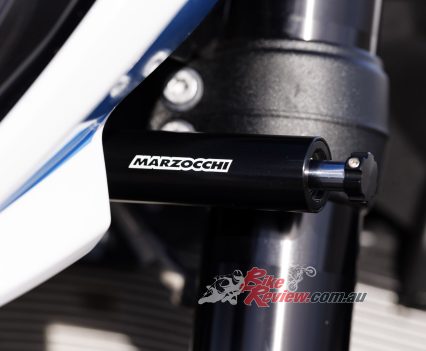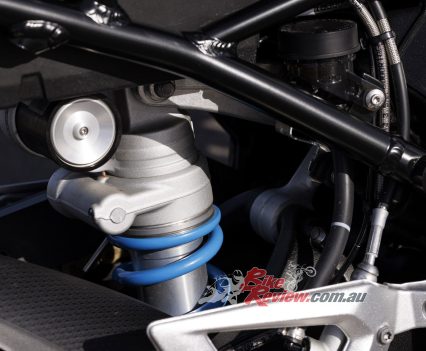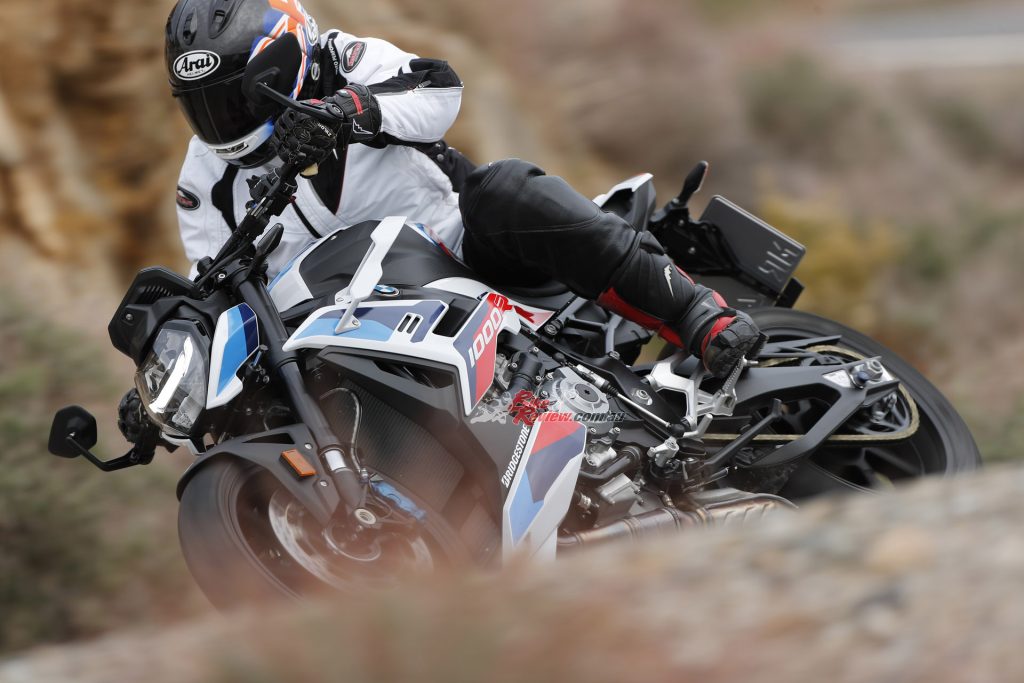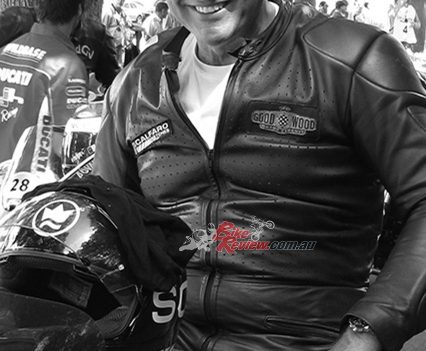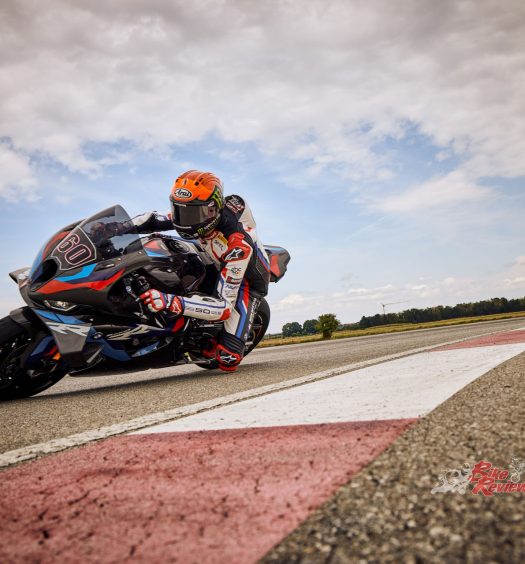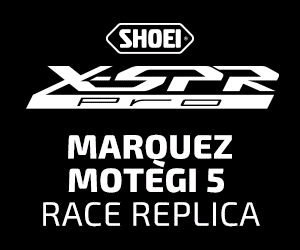Just as half of the bike industry are claiming that performance is dead, BMW remember why we love bikes and create this beast. Photography: BMW Motorrad/Markus Jahn and Jörg Künstle
Nothing succeeds like excess – and by concocting the M 1000 R, BMW is doing its best to confirm the truth of that axiom in a two-wheeled context. How else to characterise a Naked-as-Nature straight-four hotrod with upright handlebar and no screen?
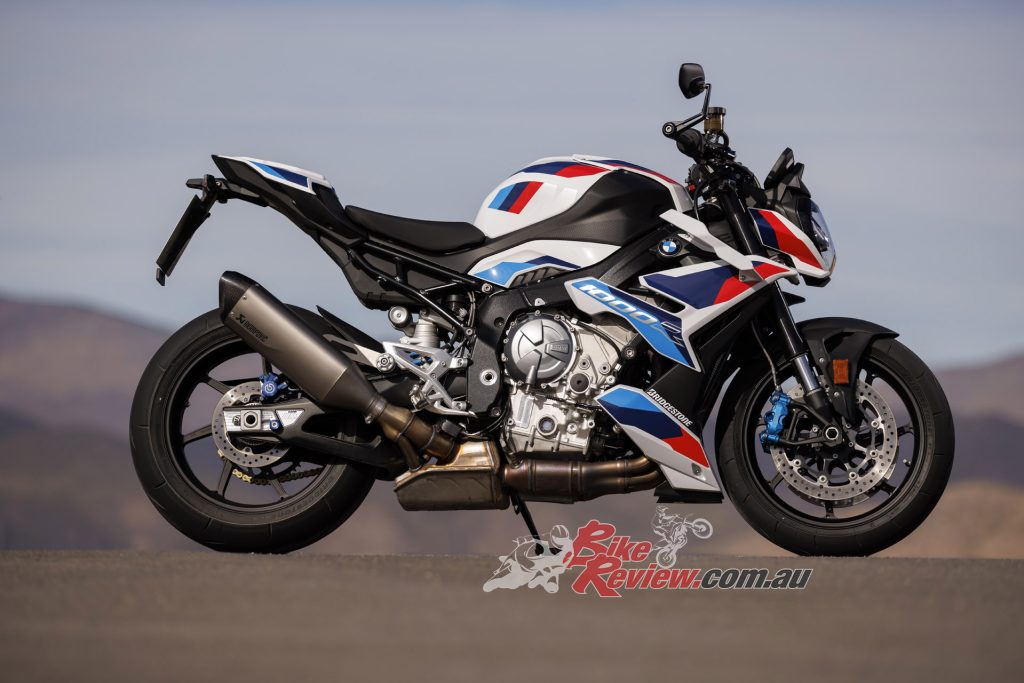
Alan attended the BMW M 1000 R and S 1000 RR Test at Almeria, Spain. The S 1000 RR test will be up ASAP.
Not to mention that the MR (as BMW would like us to call it) has a 14,600rpm redline and produces 154kW/206.5bhp/210PS at 13,750rpm, with peak torque of 113Nm/83.3lb-ft at 11,000rpm, that it has a homologated/proven top speed of 280km/h and weighs just 199kg with all liquids, including a full 16.5-litre tank of fuel – so 186kg half-dry? Consider that just a decade ago the factory S 1000 RR Superbike racer which BMW’s works riders Troy Corser and Leon Haslam raced in the 2011 WSBK series produced 216bhp at 14,900rpm (as tested by Jeff here), and it’s clear that the new MR super-roadster is a statement of intent that can’t be ignored.
Check out our BMW S 1000 R M Sport review here...
In what’s surely the most competitive model segment in real world road riding right now in terms of performance and allure, with the debut of the power-up M-version of its existing S 1000 R Roadster producing a ‘mere’ 121kW/162bhp/165PS, BMW is throwing down a ‘beat-that’ gauntlet to its Ducati, Aprilia, MV Agusta and KTM rivals for the normally aspirated SuperNaked crown – as well as anyone else thinking of joining the party. Like Yamaha, maybe, did I hear you say?
BMW has achieved this by essentially transplanting the engine, lean-sensitive electronics, suspension and much of the transmission from the latest version of its S 1000 RR Superbike contender, to create the excessive excellence represented by this new aero-equipped uber-Roadster. And it’s done so without detuning that hardware or downgrading the software in any way, simply delivering what amounts to two bikes in one by the smoothness with which something that’s happy being ridden around towns and suburbs at lower revs and everyday speeds, is transformed on the open road into a fire-spitting missile of a motorcycle at anywhere above its 8,000rpm super-power threshold.
“The result is a motorcycle which will surely out-perform any customer Superbike-with-lights anyplace you care to ride – except on a racetrack with sustained high speeds”…
But as a 250km ride on the BMW press launch along the superb but deserted pork-barrel roads of southeast Spain, followed by a disappointingly scant four laps of the Almeria circuit, confirmed, the result is a motorcycle which will surely out-perform any customer Superbike-with-lights anyplace you care to ride – except on a racetrack with sustained high speeds, where the virtues of a lower, more streamlined riding position and more focused racetrack handling, will assert themselves. But on a tight track like Almeria minus its kilometre-long main straight, I’d bet most expert riders could lap faster on this Naked Superbike than on the S 1000 RR it’s essentially derived from.
The MR’s aggressive appearance is directly derived from the heavily revamped S 1000 R that BMW introduced in 2021, and it retains the twin-beam Flex Frame aluminium chassis of that stock roadster with the 80 x 49.7mm DOHC 16-valve Euro 5-compliant wet sump in-line four-cylinder 999cc engine whose cylinders are inclined forward 32° from vertical, acting as a fully stressed chassis member.
Check out the full tech breakout and details of the M 1000 R here…
Its four titanium valves per cylinder (33.5mm intakes with hollow stems/27.2mm exhausts with new springs and a different exhaust cam profile) are operated by finger cam followers via the ShiftCam variable intake system which BMW introduced in 2019 on the 1250GS, then on the S 1000 RR, but hadn’t yet included on any Naked model. Until now.
This combines both variable valve timing and differential valve lift, all in the same package, as a means of optimising cam timing and duration for what you’re asking the engine to do. For part-throttle openings, or lower down in the rev range, the intake cam has a shorter lift and reduced duration, meaning the valves are open less. But ask for more throttle or higher revs, and the cam shifts sideways, bringing into play a higher lift, longer duration cam lobe, more suited to outright performance.
This has been a feature of the S 1000 RR for some time, and is a key element in the MR’s best-of-both-worlds demeanour. It delivers an increase in torque and pulling power in the lower to medium rev range, while simultaneously offering a gain in peak power. This allows the MR engine to offer almost the same high torque in the lower and middle ranges as the S 1000 R motor, but with the same peak power as the RR. See what I mean about two bikes in one?
To complement this, much attention has been paid to tailoring the Superbike’s transmission to suit this punchier Roadster application. Overall gearing has been lowered significantly with a 2T bigger rear sprocket, up from 45T to 47T, so you can dial up the revs more easily to access that extra power and torque, while internal ratios of the six-speed gearbox have also been altered, with lower 4th, 5th and 6th gears for meatier acceleration.
“Internal ratios of the six-speed gearbox have also been altered, with lower 4th, 5th and 6th gears for meatier acceleration”…
But there’s still the same slipper clutch and two-way powershifter whose shift pattern can be quickly swapped to a race-pattern format, if desired. An all-new Akrapovič exhaust with titanium silencer is fitted as standard, as is the M Endurance chain developed in BMW’s official World Endurance team.
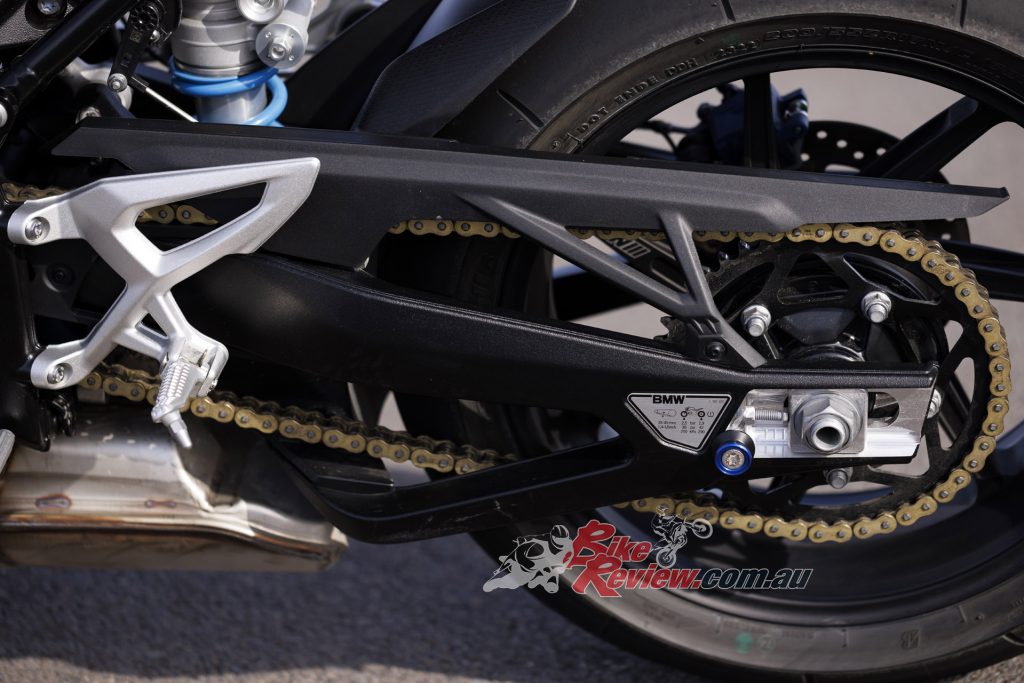
“An all-new Akrapovič exhaust with titanium silencer is fitted as standard, as is the M Endurance chain developed in BMW’s official World Endurance team.”
Highlighting the extra step in performance are the two imposing winglets mounted either side of the cockpit, and thus in your peripheral view at all times, just to remind you what you’re riding. These aren’t a mere styling feature, but produce genuine downforce at the front end, say BMW engineers, adding a claimed 11kg/24lb of thrust onto the front wheel at 220km/h, thanks to being mounted on a subframe aka ‘substructure’ which transmits that force into the chassis, and thereby to the front wheel.
Highlighting the extra step in performance are the two imposing winglets mounted either side of the cockpit…
This helps reduce wheelies, so improves acceleration, as well as enhancing front tyre grip during braking and cornering, and although the winglets inevitably add drag, the engine’s extra power more than compensates for that.

“These aren’t a mere styling feature, but produce genuine downforce at the front end, say BMW engineers, adding a claimed 11kg/24lb of thrust onto the front wheel at 220km/h”…
On the M Competition Package version of the MR there’s an additional wind deflector to direct airflow over the rider, plus an optional windscreen is available as one of the several dedicated MR accessories. Speaking of which, the MR lists at $32,290, but to obtain the M pack (black paint, carbon wheels, adjustable M-footrests and additional carbon parts including front and rear huggers, chain guard and tank covers, plus that deflector) and thereby save another 1.6kg in weight, you’ll need an additional $7,600 – although all of those items may be purchased individually as accessories.
This modern version of a two-wheeled Panzer – German’s legendary WW2 tank, which offered ‘a perfect combination of speed, agility, firepower and reliability’, according to historians! – has an evolved electronics package with of course a Ride by Wire/RBW throttle offering five different riding modes – Rain, Road, Dynamic and Race, plus Race Pro which also gets three levels of throttle response and engine braking options.

“These, combined with a triple-axis, six-direction IMU, control the array of rider aids, most of them switchable”…
These, combined with a triple-axis, six-direction IMU, control the array of rider aids, most of them switchable: Cornering ABS Pro, multi-stage DTC, engine braking adjustment, anti-wheelie, hill start assistance, launch control, cruise control, a lap timer, three-stage heated grips, a pit lane speed limiter, engine braking torque control (MSR) and the Dynamic Brake Control (DBC), which offers additional assistance during emergency braking.
“The more adept or just plain brave will also appreciate the Brake Slide Assist system that lets you maintain a constant slide into a corner by limiting rear brake pressure and rear wheel slip…”
The more adept or just plain brave will also appreciate the Brake Slide Assist system that lets you maintain a constant slide into a corner by limiting rear brake pressure and rear wheel slip to achieve a controlled, pre-determined drift angle, before the lean-sensitive ABS cuts in. Let’s just say I needed more practice than just four laps of Almeria to get dialed in to use this!

You can tune each mode to suit your own preferences, or switch between the different settings for riding solo or two-up…
The MR also gets fully adjustable new Marzocchi suspension including a blacked out 45mm upside-down fork offering 120mm of wheel travel and a rear monoshock delivering 117mm of travel, on both of which electronic Dynamic Damping Control (DDC) is standard, linked to the bike’s riding modes. So in Rain and Road the damping is more comfort focused, with Dynamic, Race and Race Pro each representing one stage stiffer towards fully track-orientated settings.
You can tune each mode to suit your own preferences, or switch between the different settings for riding solo or two-up, via the suspension menu on the TFT dash, accessed via BMW’s familiar scroll wheel on the left ‘bar. And switching between the different riding modes on the move via the switch on the right ‘bar is simple and effective.

Alan had a good crack on the Spanish roads but sadly only got four laps on the circuit to try and explore the true limits of the bike, thus this is a road test more than anything.
The MR’s quite conservative chassis geometry, with a 1450mm wheelbase, a 24° fork rake and 97.6mm of trail, is presumably aimed at stability which, thanks also to the winglets, is delivered in spades. My four measly laps of the Almeria circuit provided a great tester of that, holding the throttle nailed open on that kilometre-long ribbon of Spanish blacktop.
Unless your name is Dani Pedrosa, there’s a limit to how far you can tuck yourself down flat on the ‘tank’ to minimise the windblast that your upper body will inevitably face, and that’s usually a recipe for the front wheel to start wandering, as your arms are tugged this way and that by your shoulders catching the breeze in the absence of any bodywork.
Not on the MR at the 257km/h speed I saw briefly on the 6.5in TFT dash before chickening out and slamming on the brakes for the second-gear 90 degree right-hander at the end. It sat steady as a rock each lap all the way down the straight, even when I got zapped by one of BMW’s factory Endurance racers I was sharing the track with, when the brief flap of the ‘bar caused by his slipstream was swiftly annulled by the MR’s adjustable steering damper. I must have given him a nice upright air pocket to draft me in for a few milliseconds, though!
Back out in the real world on the Spanish highways, the MR’s tallish 840mm-high seat (there are lower 810mm and higher 850mm options) and the flat handlebar mounted on 80mm risers cast into the upper triple-clamp delivered a great straight-backed stance for my 180cm stature, with just a slight forward inclination to grasp the ‘bar’s meaty grips.
Thanks to the astute narrowing of the stepover at the front of the seat I could easily put both feet on the ground at rest – hence the big difference in the height gap between the stock seat and the lower one, because I reckon lots of potential shorter customers will surprise themselves when they sit on this bike for the first time, in how relatively easily they can feel at home. Of course, you can link your smartphone to the screen via Bluetooth, and the free BMW Motorrad Connected app also offers point-by-point navigation directly via the great-looking easy-to-read TFT screen.

“This is a silky SuperNaked with a smooth, seamless power delivery off the cam, i.e. anywhere up to eight grand on the TFT dash.”
Controls are light and precise, as you expect from BMW, and the powershifter works perfectly – it’s not too sensitive, but practically intuitive. So you only need to use the clutch when departing or arriving at the scene, or in slow traffic, which is just as well, as it’s quite a heavy pull. Rather improbably, because it looks so butch, this is a silky SuperNaked with a smooth, seamless power delivery off the cam, i.e. anywhere up to eight grand on the TFT dash.
There’s another more track-focused display with stuff like lean angles, brake pressure, DTC intervention and suchlike, too. But where the MR really scores is not so much the power, though there’s plenty of that even lower down the revscale, but in its torque delivery.

“Acceleration is both thrilling and all-consuming, with your upright stance somehow making it all the more riveting.”
Top gear roll-on from only just off idle is monstrous – there’s not much difference in outright maximum torque between the MR and the S 1000 R, but the ShiftCam system allows BMW to give you much more grunt at lower to midrange revs, without sacrificing anything up top. Above 5,000rpm there’s a notably greater appetite for revs – but then just over 8,000rpm things get really exciting, as the motor takes off towards the 14,600rpm revlimiter with an explosive but controllable intent that can’t be denied.
Acceleration is both thrilling and all-consuming, with your upright stance somehow making it all the more riveting. This is a seriously fun ride, which does vibrate a little over 8,000rpm, but to be honest you have other things to worry about at the speeds you’re going at!

“You can enter a third gear bend too fast to get round, back off the throttle to recover from your error, and before you’ve actually used the brakes, you realise that the MR’s electronics have gone and done it for you”…
It’s a ride that makes you glad that at the other end of the straight you just fast-forwarded down you have such excellent brakes on the MR, sourced from the M 1000 RR Superbike. The qualities of these Nissin monoblock fixed radial brake calipers so nicely anodised in blue with the ‘M’ (Motorsport) logo in gripping the 320mm floating front discs, with a single-piston floating rear caliper biting on a 220mm fixed rear disc, were repeatedly demonstrated by the totally confidence-inspiring way they hauled the MR down from high speed, yet allowed you to just finger the radial master-cylinder’s lever lightly at slower speeds to come to a halt in traffic.
The adjustable radial master cylinder’s lever is designed to flip up rather than snap off in a low-speed crash. But ironically I found I didn’t need to use it much in successive hillside twists and turns, because the mapping of the engine braking control map was so well chosen – truly stellar. You can enter a third gear bend too fast to get round, back off the throttle to recover from your error, and before you’ve actually used the brakes, you realise that the MR’s electronics have gone and done it for you, by delivering just the right amount of engine braking to take the turn. Moreover, they’ll also close the corner entry for you, so that you’re back where you ought to have been in the first place, but for your excess of ambition. Uncanny!
Despite its weight, and bulk, the MR’s steering is light but precise, which was especially noticeable flip-flopping from side to side through a series of turns, without any sense that the bike wanted to tip into an apex – it allowed quick, easy changes of direction that were all but intuitive, and certainly not hard work. A key aid in doing so was almost certainly the Bridgestone RS11 17-inch tyres, the rear 200/55 one of which was specially developed for the BMW. Helped by the great leverage from the taper-section one-piece handlebar, their rounded shape really helps the MR to change direction effortlessly, with good feedback especially from the 120/70 front via the stock fork settings that I didn’t alter. This is a really agile motorcycle, despite its physical bulk.
Check out the Australian M 1000 R page here…
I was also on the lookout when I first set out for Bridgestone’s traditional slow warm-up time in cool-ish 16°C early winter Spanish riding conditions, but I must admit this wasn’t an issue here, so maybe they’ve licked that problem. And the suspension was excellent, especially its response to the BMW being chucked into a third-gear apex with a downhill approach, where the electronic fork didn’t bottom out, but just sucked up the ridge in the pavement immediately afterwards as if it didn’t exist.

As always with BMW’s M-range build quality on the M 1000 R is phenomenal, and the whole bike is optimised down to the last detail.
As the day went by I experimented with riding modes and settings, and after starting out on Road while I got used to the MR I then switched to Dynamic, which had a crisper, sharper throttle response, as well as stiffening up the suspension nicely for the smooth surfaces of those lightly travelled roads. Rain is what it says on the label, but we didn’t get any – I ended up using Road for riding in town – and Race had too sharp a pickup from a closed throttle on the street, whereas it was excellent for my four-lap track taster.
“You get the feeling that a lot of thought went into making this motorcycle…”
As always with BMW’s M-range build quality on the M 1000 R is phenomenal, and the whole bike is optimised down to the last detail. Even the bar-end mirrors are made of forged aluminium, and the massed integration of cables and hoses to produce such a clean-looking device is really praiseworthy. You get the feeling that a lot of thought went into making this motorcycle.
The BMW M 1000 RR uber-Superbike introduced two years ago was the first M-motorcycle from the German manufacturer, complementing its line of iconic high performance cars bearing the M-badge to have been produced over the past 40 years. The man widely credited with re-establishing BMW’s ‘M Performance’ customer motorsport division back in the 1980s was the late, great Karl-Heinz Kalbfell, who worked at BMW from 1977 to 2004, before moving to Italy to head up Alfa Romeo and Maserati.
The man widely credited with re-establishing BMW’s ‘M Performance’ customer motorsport division back in the 1980s was the late, great Karl-Heinz Kalbfell…
Besides also being the man who played a key role in relaunching MINI and Rolls-Royce under BMW’s ownership, and took BMW into Formula 1, he was the one of the most avid of the many hardcore motorcyclists in BMW’s top management, but was tragically killed at Brands Hatch in 2013 racing his Matchless G50 in a British National Historic Championship event, aged 63.

Karl-Heinz Kalbfell was the one of the most avid of the many hardcore motorcyclists in BMW’s top management.
I was honoured to know him and to have raced against him several times at the Goodwood Revival and other events, at which he was a jocular paddock presence with a passion for two wheels. We often talked about BMW Motorrad’s ongoing process of reinvention since the start of this century – a process epitomised by the debut in April 2008 of the S 1000 RR, BMW’s long-awaited first four-cylinder motorcycle (read our previous model S 1000 RR review here). Keep an eye out for Alan’s 2023 test.
“Karl-Heinz insisted it was only a matter of time before his former colleagues delivered an M-series motorcycle…”
Karl-Heinz insisted it was only a matter of time before his former colleagues delivered an M-series motorcycle, and I’m sure he was smiling looking down at the debut of the M1000RR Superbike. But he’ll have been dancing on the tables of Heaven when BMW Motorrad launched the M1000R, for in my opinion after riding it this is truly a motorcycle fit to wear the M-badge, denoting that irresistible blend of leading edge performance engineering with real-world sporting road manners.
I’ve long regarded the Aprilia Tuono 1100 Factory as the ultimate motorcycle currently available for everyday real world use, and until now I haven’t felt any members of the so-called 200PS Club have toppled it from its rostrum. But after riding the 2023 BMW M 1000 R, I reckon the Tuono’s day may well be done. A comparo test beckons….!

“This is truly a motorcycle fit to wear the M-badge, denoting that irresistible blend of leading edge performance engineering with real-world sporting road manners.”
Australian pricing: M 1000 R: $32,290* M 1000 R with M Competition package: $39,890* *Recommended Retail Pricing is shown and includes GST, but excludes on-road costs. Customers are advised to contact their nearest BMW Motorrad dealer for all pricing enquiries.
Read our Aprilia Tuono V4 1100 versus S 1000 R M Sport comparo here…
2023 BMW M 1000 R Specifications
Price: From $32,290 Ride Away ($39,890 R/A as tested)
Configure your bike and price here
Claimed Power: 154kW[165hp]@13,750rpm
Claimed Torque: 113Nm[@11,000rpm
Wet Weight: 199kg
Fuel capacity: 16.5L
Fuel Consumption: 6.4L/100km
Engine: Liquid-cooled in-line four-cylinder engine, 999cc, DOHC, 80 x 49.7mm bore x stroke, 13.3:1 compression ratio, valve activation via individual rocker arms, variable intake camshaft control system BMW ShiftCam, Gearbox: Constant mesh six-speed with quickshifter Clutch: Self-reinforcing multi-plate anti-hopping wet clutch.
Chassis: Aluminium composite bridge Flex-Frame frame, load bearing engine, aluminium underslung double-sided swingarm. Rake: 66º Trail: 96.3mm
Suspension: Marzocchi USD 45mm telescopic fork, spring preload, compression and rebound stage adjustable with DDC, Marzocchi central spring strut rear, spring preload, adjustable compression and rebound stage with DDC.
Brakes: BMW Motorrad ABS Pro, dual 320mm rotors, radial four-piston M calipers, single rear 220mm rotor, single-piston floating caliper, conventional master-cylinder.
Wheels & Tyres: Carbon-fibre wheels, 3.50 x 17in, 6.00 x 17in, Pirelli Diablo Rosso Corsa II 120/70 ZR17, 200/55 ZR17.
Dimensions:
Wheelbase: 1450mm
Seat height: 840mm
Overall width: 812mm
Overall length: 2090mm
Overall height: N/A
Instruments & Electronics: 6.5-inch TFT screen, multiple display modes, Keyless Ride, DDC, DTC, Gear Shift Assist Pro, Riding Modes, Engine Braking Control, ABS Pro + lots more, see tech link.
The Verdict | Review: 2023 BMW M 1000 R nakedbike



